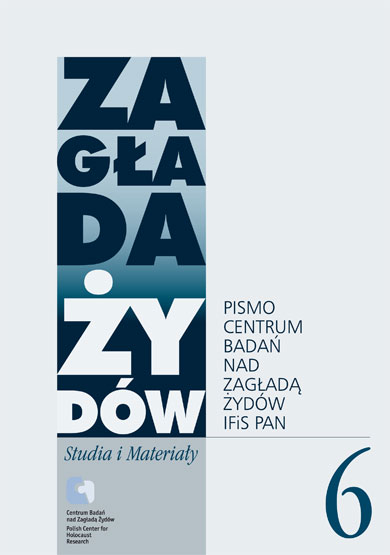„Wszystkich zabrali. Zostałam Samajedna. Bez nikogo”. Dziennik intymny Fryderyki Brück ze Stanisławowa
Zagłada Żydów. Studia i Materiały, Nr 6 (2010), Strony: 256-270
Data zgłoszenia: 2020-12-06Data publikacji: 2010-12-30
 https://doi.org/10.32927/zzsim.726
https://doi.org/10.32927/zzsim.726
Abstrakt
The article is an introduction to Fryderyka Brück’s diary covering notes from 7 May 1941 to 1 August 1942. The author of the diary came from a highly Polonized, welloff Jewish family living in Stanisławów. Her diary begins when she is only a carefree 19-year-old student with a peaceful life. The situation changes drastically after Germans have occupied the town. Fryderyka describes the first Nazi action conducted on Jews and Poles in Stanisławów when together with other representatives of the intelligentsia her father was arrested. One of the most tragic events reported in the diary is a bloody massacre of Jews in the cemetery when 10,000 Jews were killed on 12 October 1941. The notes cover the times of the move to the ghetto and life in the closed district. The girl describes the moment when on 31 March 1942 the whole of Brück family, except for Fryderyka, was taken and transported to the camp. At that
time, there is the longest gap in notes and later – the last hastily and carelessly written entry reporting chaotic events from four months. The main subject of the diary is not historical events but the relationship with Misiek Bachar. Therefore, the diary has the character of intimate notes, not intended to be read by third party. The narrative line is the emotional life, the author’s love adventures and sexual experiences. She always presents the events from the perspective of personal experience. Therefore, it might be said that it is an ordinary diary of an “average” teenager but this is what its power of message consists in nowadays. The intimacy and the specific naivety of the diary intertwines with the terror of historical events, not necessarily made conscious but also undoubtedly repressed cruelty of the Holocaust which will ultimately interrupt the author’s confessions.
Słowa kluczowe
dziennik intymny , kobiety i Zagłada , Stanisławów , getto
Licencja
Prawa autorskie (c) 2010 Autor & "Zagłada Żydów. Studia i Materiały"

Utwór dostępny jest na licencji Creative Commons Uznanie autorstwa 4.0 Międzynarodowe.
https://creativecommons.org/licenses/by/4.0
Podobne artykuły
- Michel Laffite, Jonathan Littell, Les Bienveillantes , Zagłada Żydów. Studia i Materiały: Nr 3 (2007)
- Jacek Leociak, Miriam Akawia, Haderech ha’acheret , Zagłada Żydów. Studia i Materiały: Nr 3 (2007)
- Anna Abakunkova, Obecny stan badań nad Zagładą na Ukrainie , Zagłada Żydów. Studia i Materiały: Nr 10 (2014)
- Audrey Kichlewsky, Omówienia najnowszej literatury na temat Zagłady Żydów: Francja , Zagłada Żydów. Studia i Materiały: Nr 3 (2007)
- Jan Grabowski, Przyczynek do biografii Ireny Sendlerowej (z dokumentów warszawskiego Ratusza) , Zagłada Żydów. Studia i Materiały: Nr 10 (2014)
- Dariusz Libionka, Jan Grabowski, Meldunki Obwodu „Praga” Policji Polskiej o zatrzymaniach Żydów w Warszawie w okresie maj–lipiec 1943 r. , Zagłada Żydów. Studia i Materiały: Nr 10 (2014)
- Joanna Tokarska-Bakir, Sprawiedliwi niesprawiedliwi, niesprawiedliwi sprawiedliwi , Zagłada Żydów. Studia i Materiały: Nr 4 (2008)
- Marnix Croes, Zagłada Żydów w Holandii a odsetek ocalałych , Zagłada Żydów. Studia i Materiały: Nr 4 (2008)
- Paweł Szypulski, Janina Struk, Holokaust w fotografiach. Interpretacja dowodów , Zagłada Żydów. Studia i Materiały: Nr 3 (2007)
- Aleksandra Ubertowska, Berel Lang, Nazistowskie ludobójstwo. Akt i idea , Zagłada Żydów. Studia i Materiały: Nr 3 (2007)
<< < 9 10 11 12 13 14 15 16 17 18 19 20 21 22 23 24 25 26 27 28 29 30 31 32 33 34 35 36 > >>
Możesz również Rozpocznij zaawansowane wyszukiwanie podobieństw dla tego artykułu.
 English
English
 Język Polski
Język Polski








